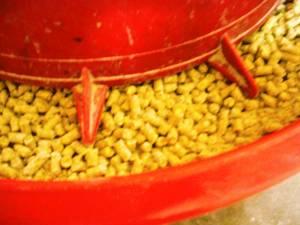Feeding broilers high-quality pellets
The modern broiler responds to improved feed form by increasing feed intake and consequent live weight gain.
Research consistently demonstrates production benefits associated with feeding pellets to poultry. These benefits include the following:
- improved feed handling at the mill and on the farm
- greater hygienic quality of feed
- reduced feed wastage
- decreased ingredient segregation
- decreased opportunities for selective feeding
- increased feed intake and subsequent live weight gain
- decreased feed conversion ratio
Read also: The importance of body weight management
Current ingredient prices, the prevalence of greater by-product inclusions in diets and feed volume requirement raise questions about the economic importance of pellet quality. While the relationships among thermal processing, feed form, nutrition and poultry performance are complicated, data has been generated at the West Virginia University feed laboratory that may enable better informed management decisions to be made concerning the manufacture and feeding of pellets.
Feed form evaluated
 Learn More
Learn MoreThe objective of the current study was to explore feed form effects on modern-day Cobb-500 broiler performance when nutrient availability was consistent among treatments.
Four variations in feed form were manufactured and fed to Cobb 500 broilers in the growing period from day 21-38. Broilers were fed a common starter diet from day one to 20. All diets were manufactured at the West Virginia University pilot feed mill. Feed manufacture was simplified so as to not confound the treatments with any thermally induced nutritional effect.
Diets were corn- and soybean-meal based, formulated to National Research Council guidelines, and contained 3% mixer added fat. Recent research from our laboratory has shown that increased levels of mixer added fat, i.e. 3%, can alleviate negative nutritional effects generated by friction/heat within the pellet die, especially when techniques are utilized to produce high-quality pellets.
Pelleting technique
The pelleting technique used in this study included a slow production rate (within the pellet mill manufacturer’s recommendation), a thick pellet die (1.77 x 3/16”), a high steam conditioning pressure (80 psig) prior to the conditioner and a high steam conditioning temperature (200 F).
This technique created a high-quality feed with 90% pellets and 10% fines. Variations in pellet quality were created by grinding a portion of the high-quality pellets via roller mill to produce fines. Fines were then mixed with intact pellets to create different pellet-to-fine ratios (percentage pellets:percentage fines).
The four feed form treatments were high pellet quality 90:10, medium pellet quality 60:40, low pellet quality 30:70 and ground pellets 0:100.
Read also: Different types of poultry feed
Improved feed form yields results
The Cobb 500 broilers had decreased feed conversion ratios when fed diets containing intact pellets. The highest carcass weight (day 39) was obtained when broilers were fed HPQ in comparison to all other treatments. The modern broiler appears to respond best to an improved feed form by increasing feed intake, and consequent live weight gain, with improved feed conversion being more of a minor response.
An economic model that set feed costs at $300/ton multiplied by feed intake/[(carcass weight) – (60% x 21d chick weight)] found a savings of $0.02 per pound of carcass weight when feeding HPQ versus GP (Table 1). In addition, a linear model generated from the data indicated that with each 10 percentage point increase in intact pellets there was a 0.4 point improvement in FCR, a 0.35 oz. increase in carcass weight and a 0.14 oz. increase in breast weight.
This research explored all combinations of the established benefits of feeding pellets except for ingredient segregation and increased pellet length effects. If ingredient segregation and pellet length effects were included in the design of this study, then the benefits of feeding high-quality pellets would likely be more dramatic. In addition, birds used in this study were only grown to 39 days. A longer grow-out period may accentuate feed quality benefits.
Investment justification
These data may encourage a company to consider if an investment of time, utility cost and labor to produce pellets of high quality would justify improvements in live production and overall profitability. More specifically, the feed mill may have to operate an additional day per week or additional shift, and electrical and gas inputs at the mill would likely increase.
Throughput may be enhanced via increased inclusions of mixer-added fat or high-fat ingredients such as distillers dried grains with solubles or bakery by-product meal. However, pellet quality effects must be considered.
If feed manufacture strategies translate to improved bird weight gain, and less feed and time are required for grow-out, then the added investment required to create pellets of high quality may be well justified.
Read also: Basics of biosecurity for Poultry growers
Pellet durability index
The MPQ and LPQ treatments in this study were composed of large, intact pellets that achieved a pellet durability index of 90%. In a practical industry setting, a diet containing 60% or 30% pellets (consistent with the MPQ and LPQ treatments) would be composed of pellets with inferior structural integrity and size.
For more information and updates join our WhatsApp group HERE
Like our page on Facebook HERE











